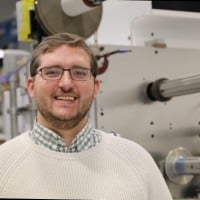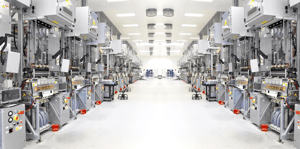How do manufacturers implement specific processes to ensure the safety and reliable performance of complex products?
In medical applications, particles in the air and the air’s moisture level can lead to bacteria growth that alters adhesion in a medical product applied directly to the skin.
Obviously, “bacteria” and “medical product” never go hand-in-hand. Yet, you can combat this using a cleanroom, which many converters (such as Strouse) possess.
This article will explore the ins and outs of ISO cleanroom certification, the industries most affected by cleanrooms, and the importance of your converting partner being certified.
What is ISO Cleanroom Certification?
Cleanroom classification ranges from ISO 1 (the “cleanest”) to ISO 9 (the “dirtiest”). Assigning these classifications is based on the maximum allowable concentration of particles per volume (cubic foot or meter) of air.
Impurities of many types — dust/smoke, equipment, microorganisms, inadequate air quality, human error, and others — can cause defects in many products.
How “clean” does a cleanroom need to be? Classifications have been established using the ISO classification system ISO 14644-1 and are rated by the cleanliness level of the air inside the room. The most common ISO classes (ISO 7 and ISO 8) indicate the room's cleanliness level based on the quantity and size of particles per air volume.
For a cleanroom to achieve ISO 7 certification, also known as Class 10,000, there must not be over 325,000 air particles (each .5 microns in size) per cubic meter.
In comparison, an ordinary room contains at least 35,200,000 particles per cubic meter, making an ISO 7 cleanroom more than 100 times cleaner.
Why use ISO 7 as an example? Because these industries regularly use ISO 7 cleanrooms:
- Medical device manufacturers
- Electronic device manufacturers
- Aerospace product development
- Pharmaceutical compounding
Not to mention laboratories in a range of industries.
ISO 7 CLEANROOM REQUIREMENTS
- HEPA fan filters
- Air locks and air conditioners
- Heat welded floors
- Sealed lighting
- Stainless steel bench
- Gowning atrium
Not surprisingly, cleanroom requirements vary based on the industry and the processes performed within the room.
ISO 7 Cleanroom By the Numbers
- Air cleanliness — maximum of 325,000 air particles (≥0.5µm) per cubic meter (m³); also called “Class 10,000” because the maximum equals 10,000 particles per cubic foot
- Air filtration — systems must provide filter coverage of 15-25% with at least 60 air changes per hour.
- Air flow rate — filtration system must be 9-16 CFM per square foot.
ISO 14644-1 — in 2001, replaced federal standard 209E (still used as a reference).
How Do You Control a Room to Achieve ISO Cleanroom Certification?
Cleanrooms must control certain environmental variables for processes within to produce complex products reliably.
Air quality is critical in cleanrooms and is the basis for ISO certification levels. Dust, dirt, and particles in the air can promote the growth of bacteria and mold over time, especially if accelerated by heat and humid environments during transportation or long-term storage of finished products.
Cleanrooms may use an industrial dehumidifier to control humidity levels. A separator filter dryer (SFD) separates dirt and air particles, filters air, and removes moisture.
In addition to environmental control equipment, workers may need to wear facemasks, hair and beard covers, lab coats, coveralls, or sterile gloves. Clothing must be made from nonwoven fabrics to prevent shedding material fibers from contaminating the room.
Even entering/exiting the cleanroom may have their own safety processes. Sticky mats remove contaminants from shoes. A “pass-thru cabinet,” usually equipped with a filtration system, is used to transfer products and limit how many people can enter and exit the room.
Should Your Converting Partner Be ISO Cleanroom Certified?
Some products simply can’t be manufactured properly and reliably outside the environment of a certified cleanroom.
When you partner with an ISO cleanroom-certified converter, you know they’re confident in taking on projects in the most demanding industries — medical devices and wound care, for instance — requiring extreme precision while following strict manufacturing guidelines for converted goods.
These converters typically have an entire team of staff design and development engineers, allowing them to invest the necessary time and resources for each project. A converter with cleanroom may offer these services to meet strict regulations:
- Custom rotary, flat bed, and laser die cutting of specialty materials
- Laminating, slitting, and rewinding … all in a climate-controlled environment
- Continuous roll-to-roll manufacturing
- Assembly
- Packaging
Just as new technology advances materials and products, contamination threats also increase, so cleanroom best practices also need to evolve.
Cleanrooms must follow best practices to ensure consistent performance that meets requirements. These may include gowning procedures, housekeeping processes/schedules, training, auditing, and making necessary improvements.
Finding a Partner with Cleanroom Certification
Whether you’re thinking about manufacturing in a cleanroom or know it’s a certainty for your product, it might be time to start looking for a partner with the manufacturing capabilities you need.
By this point, you’re probably wondering how to choose the best medical converting company for material sourcing and guidance on design manufacturability.
As an experienced converter with a cleanroom, it’s time for us to throw our hat in the ring. Consider checking out our manufacturing capabilities to better understand what we can offer and how we can help transform your design into a fully-fledged manufacturing process.
Otherwise, feel free to read more about ISO cleanroom certification and other manufacturing topics in our Learning Center.
Originally published: December 7, 2020







